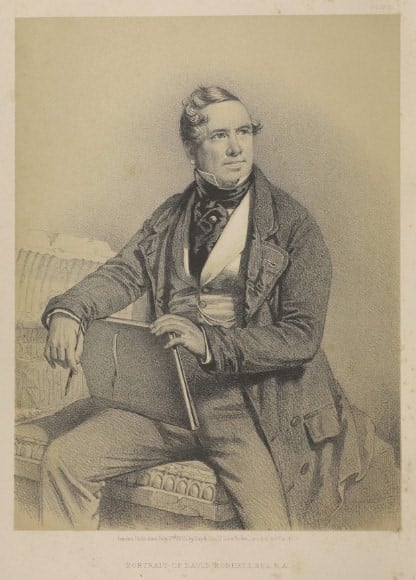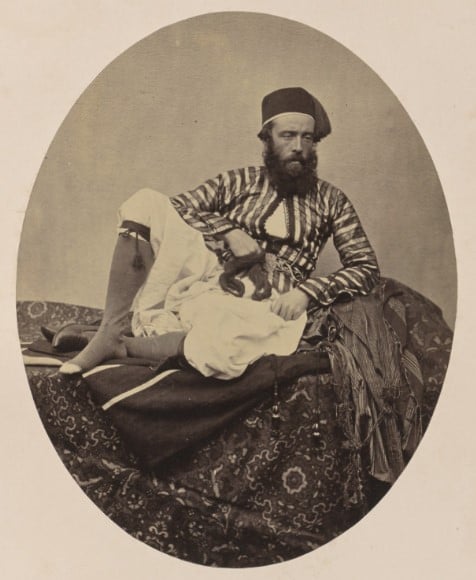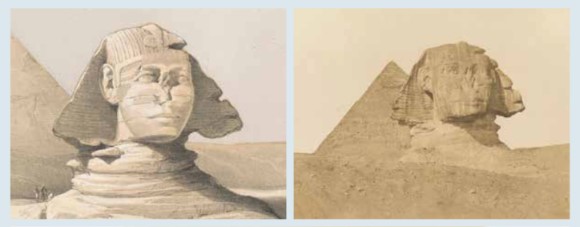In the mid-19th century, thanks to developments in printing and photographic techniques, Europeans saw images of faraway places that had rarely been glimpsed by Western eyes. Taking advantage of these emerging technologies, savvy illustrators and photographers ventured far and wide to sate the public’s appetite for views of distant locales and exotic lands.
A corresponding surge in travel books contributed to the emerging genre of armchair travel writing, which combined archaeological and ethnographic details with storytelling elements to take the reader on an evocative narrative journey.
Egyptomania
Europe’s initial fascination with the Near East can be traced to Napoleon’s Egyptian Campaign of 1798–1801. Egyptomania really took off in 1817, when the British Museum purchased an ancient Egyptian statue of Ramses II, and in 1822, when the mysteries of the Rosetta Stone were solved by explorer and Egyptologist Jean-François Champollion.
What followed was an obsession with ancient Egypt that would continue until the end of the 19th century and beyond.

David Roberts
One of the first British illustrators to take advantage of the burgeoning interest in the Middle East was Scottish artist David Roberts (1796–1864), who travelled to present-day Israel, Syria, Jordan, Egypt, Saudi Arabia and Sudan in 1838–39.
During his journey, he sketched the major sites of Egypt and the Middle East. The work that resulted – The Holy Land, Syria, Idumea, Arabia, Egypt & Nubia – was published in 1842, in the form of two series of three-volume sets.
It was a massive project. The work required the reproduction of 250 images, and Roberts had trouble finding a lithographer willing to invest the necessary time and effort in such a large and risky undertaking. He finally procured the assistance of Belgian-born Louis Haghe, ‘lithographer to Queen Victoria’, who transferred the images to nearly 500 lithographic stones, collectively weighing 16 tonnes.
A decade or so after Roberts’ work was published, both The Holy Land and Egypt and Nubia found their way to the other side of the globe, to Melbourne’s Public Library. They are listed in the Catalogue of the Melbourne Public Library for 1861, and an entry on page 161 of the Catalogue of the Melbourne Public Library stock book 1854–1865 indicates that in the 1850s the two sets were acquired, unbound, at a cost of £10 each. They were later bound for a fee of £7 8s 6d per set, probably in 1864.

Francis Frith
In 1858, seven years after Roberts had finished publishing The Holy Land and Egypt and Nubia, photographer Francis Frith produced an album of 77 photographic views of Egypt and Palestine. Titled Egypt and Palestine Photographed and Described, the work was effectively a photographic sibling to Roberts’ illustrations.
The first publicly available photographic process was the daguerreotype, and until 1860 it was the most commonly used technique. The calotype process (or talbotype, named for the photographer who patented the method, William Henry Fox Talbot) was also popular in the 1840s and ’50s. Rather than the daguerreotype’s silver-plated copper plate, which produced only a single image, the calotype used light-sensitive paper that could be used to create multiple prints, making it a more flexible process.
Frith used neither method. Instead, he chose the collodion wet-plate process, a technique that, in various forms, would become the standard for large-format photography until the digital revolution of the 1990s.
The collodion process gave early landscape photographers the ability to capture sharper, sturdier and more predictable outdoor results than could be achieved with the calotype. However, the process was not without its problems. It required a portable darkroom for use in the field, as the image had to be exposed and developed within 15 minutes. Additionally, the heat of the desert often caused the collodion emulsion to boil over, fizzing onto the glass negative and requiring it to be reapplied.
Despite these challenges, Frith succeeded in creating one of the first commercially available photographic albums of Egypt and Palestine. His album blended fact and fiction to meet the British public’s demand for photographic views, and consequently solidified his reputation as one of the first mass producers of photographs in England.
In the Library
While the State Library is unable to boast a copy of Frith’s album of photographs, it does have an incomplete, disbanded set of 44 prints by Frith that are similar to those that appeared in Egypt and Palestine.
The background to the prints’ acquisition is a mystery, but an inscription on the cover states that they were ‘presented to the Trustees of the Melbourne Public Library by Edward Thompson Esquire’, principal librarian of the British Museum between 1888 and 1909. The donation was most likely the result of an ongoing correspondence between the Trustees of the Public Library, Museums and National Gallery of Victoria with the British Museum.
Thompson was interested in the study of archaeology and palaeography (the study of ancient writing systems), and was aware of photography’s role in disseminating items of historical and cultural significance. Recognising the educative value of Frith’s views of Egypt on the rapidly expanding colony of Victoria, he would have seen Melbourne’s Public Library as the prints’ ideal home.

Comparing sphinxes
Frith believed photography was an objective, and therefore superior, means of documenting the world compared to lithography. However, if you compare his photographs with Roberts’ illustrations of the same monuments, it’s easy to see just how much Frith was influenced by Roberts.
The two artists’ respective views of the head of the great Sphinx, for instance, share an emphasis on scale by portraying the monument from a low, narrow perspective. In both images, the Great Pyramid of Giza stands in subordination to the Sphinx’s head, emphasising the sphinx’s status as an enduring symbol of ancient Egyptian civilisation.
Unlike Frith, Roberts took a few artistic liberties in his works. The monuments he portrays are frequently populated by tiny figures that serve to emphasise the sublime and massive scale of his architectural subjects. Frith’s photographs can seem underwhelming by comparison – the image appears flattened and awkward, most likely a result of the cumbersome photographic technology he was using.
It was a concern noted by Frith in his introduction to Egypt and Palestine, in which he lamented how ‘a photographer only knows…the difficulty of getting a view satisfactorily into the camera’ and speculated about ‘what pictures we would make, if we could command our points of view!’
Despite these differences, both Roberts and Frith were driven by a desire to document and disseminate their views of Egypt and the Middle East to a readership that was as broad as possible.
In their new home in the State Library, the works could be accessed by a wide colonial readership seeking perspectives of faraway places they were unlikely to ever see for themselves.
This post was written by Stephen Jakubowicz, Library Officer.
More to explore
In addition to Roberts’ volumes and Frith’s photographs, the State Library holds a variety of materials relating to the early exploration of Egypt.
Resources include:
- An online version of David Roberts’ The Holy Land, Syria, Idumea, Arabia, Egypt & Nubia and a descriptive catalogue of 58 views of the Holy Land by Francis Frith.
- A book of Egyptian friezes by amateur Egyptologist Giovanni Belzoni.
- A book of photographs by French businessman and photographer Maxime du Camp.
- A book of engravings made after Napoleon’s expedition to Egypt in 1798.
For a more detailed look at this subject, read Stephen’s La Trobe Journal article in full.


Very interesting. One can only imagine how Victorians viewed the wonders of the Middle East. Thanks.